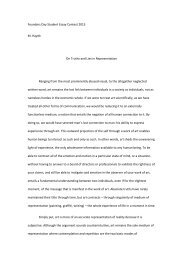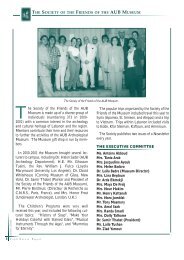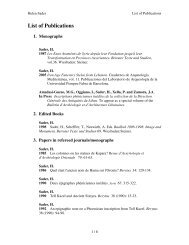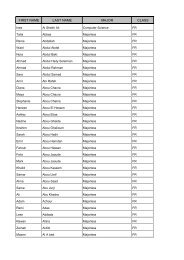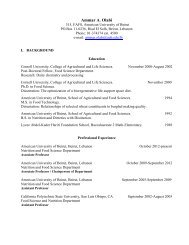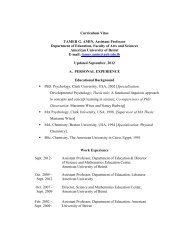The IX t h Makassed Medical Congress - American University of Beirut
The IX t h Makassed Medical Congress - American University of Beirut
The IX t h Makassed Medical Congress - American University of Beirut
You also want an ePaper? Increase the reach of your titles
YUMPU automatically turns print PDFs into web optimized ePapers that Google loves.
T h e I X t h M a k a s e d M e d i c a l C o n g r e s s<br />
UPDATES IN PEDIATRIC OBESITY: WHY SHOULD WE CARE?<br />
Nadine H Yazbeck, MD<br />
Obesity is currently the single most prevalent disease in Childhood; obese children constitute a<br />
significant portion <strong>of</strong> every primary care and specialty practice in Pediatrics.<br />
It is <strong>of</strong> utmost importance to use the percentile BMI for age and gender as the most appropriate<br />
and easily available method to screen and diagnose overweight and obesity in the general<br />
pediatrician’s clinic.<br />
In this talk I will quickly go over the different possible etiologies <strong>of</strong> this global epidemic and review<br />
the wide spectrum <strong>of</strong> complications including the respiratory, gastroenterology, endocrinology<br />
and psychological problems.<br />
I will stress mainly on the treatment with its three primary components: the dietary modifications,<br />
the increase in physical activity and the behavioral modifications for both the patient and the<br />
family.<br />
Superficially, it would seem that the treatment <strong>of</strong> overweight is straight forward: counsel children<br />
to eat less and be more physically active. In practice, treatment <strong>of</strong> childhood overweight is time<br />
consuming, frustrating, difficult and expensive. <strong>The</strong> considerable challenges <strong>of</strong> addressing and<br />
treating obesity throughout the life cycle have led to increase in interest in preventing obesity<br />
altogether.<br />
EOSINOPHILIC COLITIS<br />
Sibylle Koletzko MD and Haunersches Kinderspital, MD<br />
Eosinophilic colitis (EC) is a descriptive term for a condition characterized by eosinophilic<br />
infiltration <strong>of</strong> one or more layers <strong>of</strong> the total colon or some segments, but it is not a single entity.<br />
Primary EC is a manifestation within the eosinophilic gastrointestinal disease (EGID) spectrum 1 and<br />
occurs in all age groups, particularly during infancy. Primary EC needs to be distinguished from<br />
secondary forms, due to different infectious diseases, particularly helminth or parasitic infections,<br />
inflammatory bowel disease, hyper-eosinophilic syndrome and drugs such as rifampicin, gold<br />
or non-steroidal anti-inflammmatory drugs 2 . More recently secondary EC has been recognized<br />
in a proportion <strong>of</strong> children after liver transplantation as a side effect <strong>of</strong> immunosuppression with<br />
tacrolimus 3 .<br />
<strong>The</strong> clinical spectrum varies from hardly any symptoms to rectal bleeding, dysmotility with<br />
constipation or diarrhoea, abdominal pain or even ascitis. A peripheral eosinophilia is common;<br />
however a normal differential blood count does not exclude EC. <strong>The</strong> diagnostic work up depends<br />
on age, but infections and drug-induced EC should be ruled out. In breastfed or formula fed<br />
infants with hematochezia endoscopy is rarely needed, because in most cases the condition is<br />
self-limiting or resolves after dietary intervention 4 . Colonoscopy should be performed if symptoms<br />
persists, or in older children to differentiate from secondary forms, particularly inflammatory bowel<br />
disease. <strong>The</strong> macroscopic appearance may vary from normal to aphthous ulcerations with or<br />
without lymphatic hyperplasia. Eosinophilic infiltrations may be segmental or continuous.<br />
Treatment includes nutritional exclusion and corticosteroids. In breast-fed infants the elimination<br />
<strong>of</strong> cow’s milk protein from the maternal diet or addition <strong>of</strong> supplementary feeding after 17 weeks<br />
42






